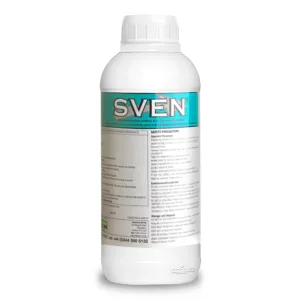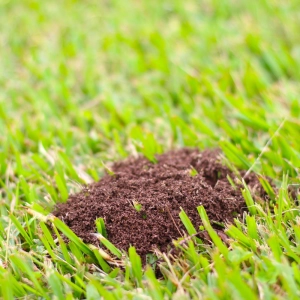Ants are very social and gather in large numbers often creating numerous ant hills in lawns and extensive nests under hard surfaces.
Identifying nests
Depending on the species, nests can vary in size from small chambers under stones, patio slabs or logs, to vast complex cavities that can develop beyond a metre in width and depth.
A complete nest can be constructed in a day or two or may take several weeks if the colony is particularly large. Some nests may continue to grow for longer periods of time, especially where a colony is producing larger flying ants in summer.
It’s usually easy to identify where ants are building nests under hard surfaces by the soil and sand they deposit on the surface during the excavation process.
A minute or two’s careful watching will show where the entrance or entrances are, giving you a good indication of where to focus your efforts.
What damage can ants do?
Ants don’t usually cause structural damage under hard surfaces, but the deposited soil and sand can be unsightly.
If they are nesting very close to the home, you may find some begin appearing inside having found their way in via small gaps in skirting boards - for example.
Anthills on lawns can be annoying as they impact the appearance of grass. They are not harmful to the turf in any way, but inadvertently mowing them can make the muddy patch look worse.
However, ants’ nests can cause damage when they nest in pots. If a previously healthy potted plant is suffering and you notice ants moving to and from the base of the pot, it could be they’ve formed a nest inside the pot.
This can end up causing damage to the plant as their nest can interfere with the roots’ ability to take up water and other nutrients.
How to prevent ants’ nests
There is nothing you can do to stop ants turning up in your garden. But there are a few things you can do to move them on.
Watering affected potted plants more regularly may encourage them to ship out as they prefer dry environments for their nests.
If you find them in your compost heap, watering regularly will help again, but try turning the compost over too so the birds can feed on them. Covering the heap will also help build up heat which will discourage them.
How to get rid of ants under hard surfaces
It is almost impossible to pour enough water down the entrance to an ants’ nest under a hard surface to move ants on. The entrances are just too small to make this an effective option.
This is why chemical elimination products exist and why you may have tried traps, powders and sprays in the past. Some are more effective than others, but they can be unsightly while using them.
Try blocking the entrance to the nest if you spot one on a hard surface. Adding a small amount of caulk or smaller stones can work and encourage the ants to build elsewhere.
How to get rid of ants in lawns and plants
Nests on lawns pose the biggest challenge. Some chemical treatments can damage the grass, and watering is unlikely to work as any moisture will be quickly absorbed by the surrounding soil.
Products like Sven will kill the ants in lawns and on other plants when used as a spot spray. It will also control a range of other damaging insects including aphids, thrips and leaf miners. Read more about ant control in our guide here.
If you’d prefer to use a non-chemical biological control, try nematodes. Steinernema Feltiae are harmless to humans, animals, earthworms or other biological controls. Ants will not tolerate nematodes close to their nests and will move on.
Have questions about ant control? Ask our specialist technical team for help today.





